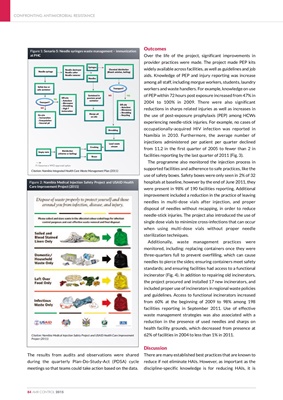
The results from audits and observations were shared
during the quarterly Plan-Do-Study-Act (PDSA) cycle
meetings so that teams could take action based on the data.
CONFRONTING ANTIMICROBIAL RESISTANCE
84 AMR CONTROL 2015
Needle-syringe
Safety box or
safe container
Needle destroyer
Needle cutter
Needle remover
Transport?
Transport?
YES
NO
On-site
- Incineration
- Encapulation
- Secured pit
Off-site
- Autoclave
- Microwave
- Shredding
- High T
incineration
Needles
Syringes
Off-site
- Autoclave
- Microwave
- Shredding
- Recycling
Chemical disinfection
(Bleach solution, boiling)
NO YES
Shredding
Contained in
puncture proof
container
Sharps pit
on-site
Crushing
Reuse
Empty vials
Local waste
stream
Disinfection
(chlorine or boiling)
If it becomes a WHO approved option
Figure 1: Senario 5: Needle syringes waste management - immunization
at PHC
2007 20
If it becomes a WHO approved option
Figure 2: Namibia Medical Injection Safety Project and USAID Health
Care Improvement Project (2011)
Citation: Namibia Medical Injection Safety Project and USAID Health Care Improvement
Project (2011)
Citation: Namibia Integrated Health Care Waste Management Plan (2011)
Outcomes
Over the life of the project, significant improvements in
provider practices were made. The project made PEP kits
widely available across facilities, as well as guidelines and job
aids. Knowledge of PEP and injury reporting was increase
among all staff, including morgue workers, students, laundry
workers and waste handlers. For example, knowledge on use
of PEP within 72 hours post exposure increased from 47% in
2004 to 100% in 2009. There were also significant
reductions in sharps related injuries as well as increases in
the use of post-exposure prophylaxis (PEP) among HCWs
experiencing needle-stick injuries. For example, no cases of
occupationally-acquired HIV infection was reported in
Namibia in 2010. Furthermore, the average number of
injections administered per patient per quarter declined
from 11.2 in the first quarter of 2005 to fewer than 2 in
facilities reporting by the last quarter of 2011 (Fig. 3).
The programme also monitored the injection process in
supported facilities and adherence to safe practices, like the
use of safety boxes. Safety boxes were only seen in 2% of 32
hospitals at baseline, however by the end of June 2011, they
were present in 98% of 190 facilities reporting. Additional
improvement included a reduction in the practice of leaving
needles in multi-dose vials after injection, and proper
disposal of needles without recapping, in order to reduce
needle-stick injuries. The project also introduced the use of
single dose vials to minimize cross-infections that can occur
when using multi-dose vials without proper needle
sterilization techniques.
Additionally, waste management practices were
monitored, including: replacing containers once they were
three-quarters full to prevent overfilling, which can cause
needles to pierce the sides; ensuring containers meet safety
standards; and ensuring facilities had access to a functional
incinerator (Fig. 4). In addition to repairing old incinerators,
the project procured and installed 17 new incinerators, and
included proper use of incinerators in regional waste policies
and guidelines. Access to functional incinerators increased
from 60% at the beginning of 2009 to 98% among 198
facilities reporting in September 2011. Use of effective
waste management strategies was also associated with a
reduction in the presence of used needles and sharps on
health facility grounds, which decreased from presence at
62% of facilities in 2004 to less than 1% in 2011.
Discussion
There are many established best practices that are known to
reduce if not eliminate HAIs. However, as important as the
discipline-specific knowledge is for reducing HAIs, it is